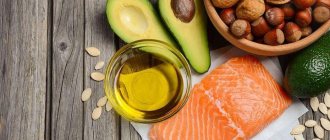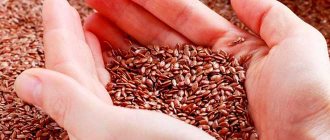It is important to maintain a healthy ratio of omega 3 to omega 6 intake, which ranges from 1:2-1:4. At the same time, the optimal daily intake for a healthy person is 1 gram (1000 mg), the minimum is 0.25 grams and the maximum is 7 grams. You should exclude or limit the amount of foods that contain excessive amounts of omega 6 from your diet, as their excessive amounts create a number of health problems.
In the table below you can find out how many grams of omega 3 and omega 6 are contained in 100 grams of product and balance your diet. The main source of omega 3 is fish, but for people who do not eat it (there are quite a lot of them), you should consider using encapsulated omega-3.
- Vegetable oil
- Fish and seafood
- Seeds and nuts
- Vegetables and greens
- Fats, meat, eggs, dairy and legumes
Symptoms of Omega-3 deficiency
Scientists have established that there is no surplus of Omega-3. “Too much” DHA and EPA does not affect the body in any way. But a deficiency of beneficial acids can cause serious health problems. Thus, symptoms of insufficient consumption of eicosapentaic acid are:
- high blood pressure
- frequent infectious and inflammatory diseases
- dry skin
- swelling
- deterioration of memory, attention, ability to concentrate on anything
- difficulty coordinating movements
- visual impairment
- growth retardation in children
If the human body receives EPA in too small quantities, serious diseases can develop:
- arterial hypertension
- diabetes
- dermatitis
- bronchial asthma
- thrombosis
- arthritis
- osteoporosis
- immunodeficiency state
Hypertension is one of the consequences of EPA deficiency.
If the body lacks docosahexaenoic acid, the following disturbances in its functioning are observed:
- allergization occurs in the body
- a depressive state occurs
- the risk of developing cardiovascular diseases increases
- Cell aging processes occur faster
- brain function deteriorates
- children's learning ability decreases
- increased risk of developing autoimmune diseases
Absent-mindedness and learning problems in schoolchildren are associated with DHA deficiency.
IMPORTANT: Scientists associate toxicosis in pregnant women, including late pregnancy, as well as spontaneous abortion with DHA deficiency.
Omega-3
Omega-3 is rightly called the most important source of energy. They take part in many biochemical processes in the body, and a lack of these fatty acids leads to a decrease in cognitive abilities. That is, it becomes more difficult for a person to perceive, remember and analyze information; he feels distracted, forgetful, and quickly gets tired of the simplest intellectual activity.

This is mainly due to the ability of Omega-3 to regulate blood viscosity, reducing it. Thus, blood supply and nutrition of body tissues, including the brain, with oxygen, which is involved in the metabolic process, improves. At any age, low blood viscosity within normal limits facilitates the functioning of the heart and kidneys, and after 50 years it serves as a guarantee of preventing the formation of blood clots and internal hemorrhages.
Omega 6: what is it good for?
Another class of polyunsaturated fatty acids necessary for humans is Omega-6, namely:
- linoleic
- gamma - linolenic
- arachidonic

The benefits of Omega-6 and foods that contain acids.
Omega-6 also has a positive effect on the functioning of all systems of the human body. For example:
- normalizes metabolism
- improves heart function and vascular condition
- stabilizes the nervous system
- improves the condition of skin, hair and nails
- improves immunity, etc.
IMPORTANT: Omega-3 acids are difficult to obtain in normal quantities; their excess in the diet, if it happens, does not have a negative effect on the body. Omega-6 is contained in available products; consuming them in excess is realistic, and this is fraught with health problems.
Sources of Omega-6 acids are:
- vegetable oils: sunflower, corn, soybean, pumpkin, sesame, nut
- seeds and nuts
- animal fats: egg yolk, lard, butter
Normally, an adult should consume Omega-6 in an amount of up to 10 g (at least 8 g) per day.
Excess Omega-6 is fraught with poor health and health problems.
Too much fatty acids of this class can lead to:
- increased blood pressure
- decreased immunity
- development of heart and vascular diseases
- nervous disorders
- deterioration of liver function
- development of oncology
Summarize
- Omega-6s are one of the most important fatty acids that we need to get from food, as our bodies cannot produce them on their own.
- Omega-6 fatty acids help reduce nerve pain, fight inflammation, treat arthritis, may help reduce symptoms of ADHD, lower high blood pressure, reduce the risk of heart attack, and support bone health.
- Some of the best omega-6 fatty acids are found in foods such as safflower, grape seed, sunflower, poppy, corn, nut, cottonseed, soybean and sesame oils.
- Most people in developed countries consume too much omega-6 and not enough omega-3. It is very important to balance your intake of omega-6 and omega-3 fatty acids to maintain the correct balance, which will contribute to good levels of health.
Omega-3 or Omega-6 - which is better? Healthy ratio of Omega-3 and Omega-6 in the body
The question of which polyunsaturated fatty acid is better, the Omega-3 class or the Omega-6 class, is posed incorrectly. All of them are useful and necessary for the human body in their own way. It is impossible to neglect the consumption of some at the expense of others, as well as to compensate for the lack of some with others.
IMPORTANT: It is necessary not only to consume Omega-3 and Omega-6 acids in normal daily amounts, but also to maintain their balance in the body.
The optimal ratio of Omega-6/Omega-3 polyunsaturated fatty acids is:
- 10 to 1 for healthy people
- 5 to 1, 4 to 1 and 3 to 1 for people on medical nutrition (depending on the nature of the disease)
After entering the human body, oxidized during the digestion process, eicosapentaic Omega-3 acid and arachidonic Omega-6 acid are converted into eicosanoids, substances - mediators. They transmit nerve impulses from neuron to neuron or nerve endings to organs.
Eicosanoids synthesized from EPA also:
- have an anti-inflammatory effect
- prevent the development of allergies
- thin the blood
- dilate blood vessels
- prevent the formation of blood clots
- lower blood pressure
Those synthesized from Omega-6 have the opposite effect on the body. Therefore, an excess of Omega-6 with a deficiency of Omega-3 is fraught with inflammation and metabolic problems.
An imbalance of Omega-3 and Omega-6 in favor of the latter is fraught with inflammation in the body.
IMPORTANT: To maintain essential fatty acids in balance, it is necessary to rationalize your diet in favor of sufficient, but not excessive consumption of plant and animal fats, and also consult with your doctor about the advisability of using Omega-3 as a dietary supplement, how and in what form.
Risks associated with consuming omega-6 fatty acids
People with certain medical conditions, such as eczema, psoriasis, arthritis, diabetes, or breast tenderness, should consult a doctor before taking any omega-6 supplements. Borage oil and evening primrose oil have been reported to lower the seizure threshold; therefore, people who need to take anticonvulsants should use caution and discuss this with their doctor.
Some omega-6 fatty acids, such as GLA, may increase or decrease the effects of certain medications.
Additionally, consuming too much omega-6 and not enough omega-3 can cause a fatty acid imbalance, which has many negative consequences. This means you need to monitor your omega-6 fatty acid intake and improve your diet. Try the Mediterranean diet as a guide and also to control the amount of fat you consume.
Omega-6 from evening primrose oil, video
is not responsible for the accuracy of the information presented in this video clip.
Source – Fitness Pro Sources:
- NON-DRUG METHODS FOR CORRECTING PREMENSTRUAL MOOD DISORDERS: LITERATURE REVIEW. Zhilyaeva T.V. // Difficult patient. – 2021. – No. 2-3. – P. 5-9.
- PREMENSTRUAL SYNDROME: FROM THEORY TO PRACTICE. Yakushevskaya O. V. // Medical Council. – 2021. – No. 12. – pp. 146-149.
- PHYSIOLOGICAL ASPECTS OF THE USE OF FATS IN NUTRITION. Subbotina M. A. // Equipment and technology of food production. – 2009. // https://cyberleninka.ru/article/v/fiziologicheskie-aspekty-ispolzovaniya-zhirov-v-pitanii
- FATS - FOR THE MIND AND HEART. Gladyshev M.I. // Science at first hand. – 2012. – P. 33-45.
- Essential fatty acids: natural sources, metabolism, physiological functions and health implications. Bukin Yu.V. // M. - 1999. - P. 140.
- On the biological properties of vegetable oils containing linolenic acid. Yazeva L.I., Filippova G.I., Fedina N.I. // Nutrition issues. (18:3 ω-3). – 1989. – No. 3. – P. 45-50.
- Polyunsaturated fatty acids are an essential component of nutrition. HELL. Poverin // Storage and processing of agricultural raw materials. - 2008. - No. 7. - pp. 35-38.
Popular questions
Tell me, what oil is included in Ginocomfort evening primrose oil?
Unrefined or..? Hello! The composition includes an extract from evening primrose seeds, rich in essential fatty acids and amino acids.
Hello. How long can I use evening primrose oil during menopause (when I don’t use it, the symptoms return)? Is it safe for oncology? Thank you.
Hello! A course of 3 months is considered rational. Can be combined with Gynocomfort climafemin. The drug is safe for cancer.
Is evening primrose oil suitable for a 17 year old girl?
Hello! This drug can be used during adolescence.
Hello! I have copious white discharge, my labia are sore and unpleasant during sex. I can see a gynecologist only in a week. Please advise what to do now? Thank you in advance.
Hello!
At this stage, I recommend using Ginocomfort gel with tea tree oil, 1 dose once a day for 7-10 days. The composition of the gel will have an anti-inflammatory, anti-edematous effect, eliminate itching and soreness. For an accurate diagnosis, contact a specialist
Omega-9
Benefits of Omega-9

Omega-9 unsaturated fats include oleic acid. It prevents the accumulation of cholesterol in the blood, helps maintain a healthy weight, strengthens the body's protective functions, and is necessary for vascular health, hormone synthesis, normal metabolism and many other processes that ensure our health and longevity. Consumption of foods rich in omega-9 is a prevention of thrombosis, cancer, and diabetes. American scientists have proven that hemp oil, which is one of the most valuable sources of oleic acid, effectively fights cancer cells.
Sources of Omega-9
Oleic acid is found in the following foods:
- unrefined flaxseed, rapeseed, soybean, hemp, sunflower, olive oils;
- peanut, sesame, almond oil;
- pork and beef fat;
- tofu;
- cod oil;
- pork, poultry;
- almonds, cashews, hazelnuts, pistachios, pecans, walnuts and Australian nuts;
- sunflower seeds, sesame seeds, pumpkin seeds.
To compensate for the lack of oleic acid in the body, it is enough to eat a handful of any nuts every day, as long as they are soaked and raw.
Omega-9 excess and deficiency
If the body does not have enough oleic acid, a person’s mucous membranes dry out, the digestion process is disrupted, memory deteriorates, nails peel, skin dries, joints ache, arthrosis and arthritis develop, blood pressure rises, weakness, fatigue, depression develops, increased susceptibility to infections and colds due to decreased immunity. But like any healthy food, omega-9 should not be overused.
Proportions of fatty acids in the daily menu
For full health, we need to consume all natural fats - both animal and plant origin. But not only their quality is important (extra virgin oil, not refined, fresh sea fish, not frozen, smoked, fried, and farmed, raw and soaked nuts, not fried), but also their correct ratio .
Omega-6 predominates in the foods we are used to eating - sunflower oil, pork, butter, etc. For a healthy person, the proportion between omega-6 and omega-3 should be 5:1 (less omega-3), for sick people - 2:1, but today it sometimes reaches 30:1. If the balance is disturbed, omega-6, which is present in excess in the body, instead of protecting health, begins to destroy it. The solution is simple: add a spoonful of flaxseed or some other rich omega-3 oil to your daily menu, eat a handful of walnuts and treat yourself to a portion of seafood at least once a week. An excellent helper in solving this problem is fish oil, but before consuming it, it is recommended to consult a doctor.

Sufficient consumption of healthy fats and their optimal balance in the body is an essential condition for good health. Omega-3, omega-6 and omega-9 fatty acids protect us from dangerous diseases and bad mood, give us energy, help us stay young and beautiful, which is why they are so important and necessary for every person.
Alesya Musiyuk for the site “f-Journal.Ru”











